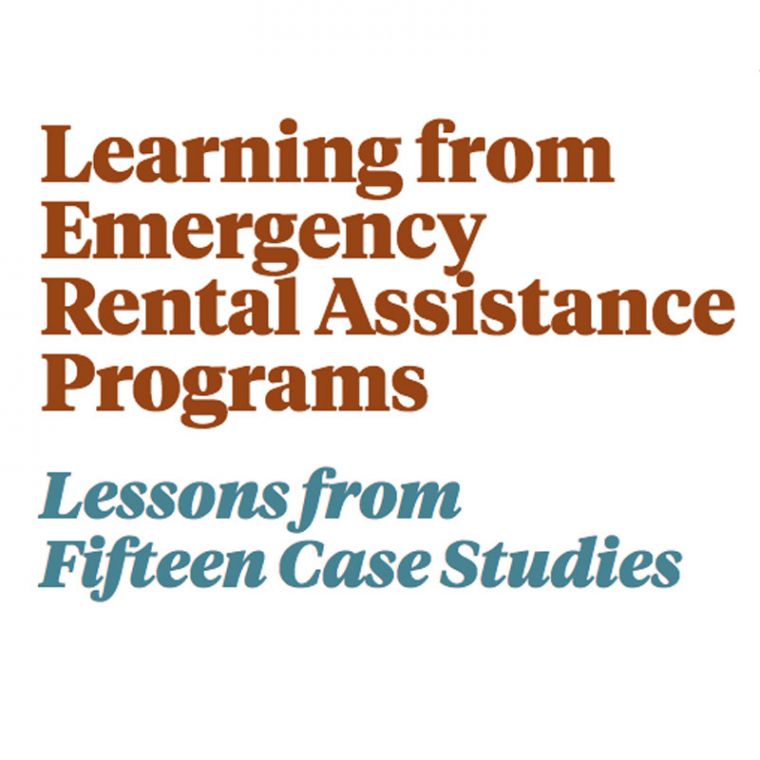
Learning from Emergency Rental Assistance Programs Lessons from Fifteen Case Studies

As the latest COVID-19 relief bill injects $25 billion in rental assistance across the nation, we have arrived at a critical moment to build on lessons learned from the local COVID-19 rental assistance programs rolled out in 2020. In order to glean best practices, the Housing Initiative at Penn (HIP), the National Low Income Housing Coalition (NLIHC), and the NYU Furman Center surveyed 220 rental assistance programs, and later conducted hour-long interviews with program administrators of 15 select programs. The programs examined in this analysis ranged from large cities to small rural communities, some demographically diverse and others more homogeneous (state-level programs were excluded).
Eight of the jurisdictions chosen had no rental assistance program prior to the pandemic. Of these 15 total programs, the most common source of funding was the CARES Act Coronavirus Relief Fund (CRF), but these funds were often supplemented by local or philanthropic funds.
A year into the pandemic, we summarize some of the key takeaways necessary to craft and implement efficient, responsive, and equitable emergency rental assistance programs.
1. Increasing Tenant Take-Up: Documentation Challenges
One chief challenge the 15 sites identified was gathering necessary documentation for rental assistance applications. Some applicants had trouble compiling documents due to a lack of familiarity with email, others lacked W-9s due to their solely cash-based incomes, and others encountered issues obtaining documents as government agencies (like Social Security offices) were closed due to the pandemic. In response, 10 of the 15 programs made their documentation requirements less burdensome. Many permitted applicants to self-certify their pandemic-induced hardship. Some allowed more flexible forms of documentation (e.g., screenshots of text messages, pictures rather than scans, electronic rather than wet signatures) to be submitted. In order to address the difficulty of getting in touch with applicants, some required documentation upfront to speed the approval process and limit the required follow-up with applicants. Six programs hired bilingual staff to assist applicants, and others created drop-off windows or other socially-distanced in-person options for applicants with limited computer access.
Many programs likewise introduced more flexible outreach strategies. Because contacting applicants multiple times can be challenging, some programs communicated via text message.
2. Targeting Vulnerable Populations and Monitoring Program Outcomes: Designing a Program around Underserved Groups
In order to best reach underserved populations–the same populations hardest hit by COVID-19–programs adopted targeted outreach and monitoring strategies. For example, to best cater to noncitizens, some programs required fewer forms of identifying documentation. To improve outreach efforts, some programs partnered with community-based organizations, and others conducted outreach in specific apartment buildings located in racially concentrated neighborhoods with high poverty rates. Some stationed outreach in shelters, food pantries, housing counseling offices, and municipal eviction courts. Once outreach was complete, programs carefully monitored the demographics (COVID-19 incidence rate, race and ethnicity, zip code, etc.) of applicants to best ensure equity. Some programs also used multilingual media and outreach materials.
3. Engaging Landlords: Reported Challenges with Landlord Participation
All but one of the 15 programs cited hardships in communicating with landlords as a problem. Some landlords were hesitant to provide official documentation, and some found the program requirements (i.e., forgiving months’ back rent) unreasonable. In response, administrators increased their outreach efforts to landlords and assisted them through the process (by creating an Excel tool that automatically calculated arrears, for instance). In cases where landlords remained resistant to participation, some programs instead raised philanthropic funds to make direct payments to tenants.
4. Boosting Efficiency: Building Capacity and Infrastructure
Small and large jurisdictions alike partnered with community-based organizations to assist with outreach, intake, processing payments, administration, translation, and tracking, among other tasks. Some jurisdictions reassigned their own staff to meet demand, others hired new (temporary) staff altogether, and some recruited volunteers. Importantly, many jurisdictions stressed a shift from a case management model–in which one staff member oversees a given applicant from start to finish–to an “assembly line” approach–in which additional staff were assigned wherever the need was greatest.
Three locales emphasized the importance of creating landlord-facing systems in order to improve efficiency. This way, by enrolling one landlord, they could serve all eligible tenants in a given apartment building, allowing for bulk processing and fewer checks. This approach led to an emphasis on large landlords, potentially at the expense of the small landlords more in need of assistance. One interviewee acknowledged this possibility and noted that they were only comfortable using this approach because they knew of other effective programs in their jurisdiction that served tenants with smaller landlords.
5. Effectively Partnering with Nonprofits: Developing an Efficient Network
As stated above, partnering with community-based nonprofits to reach underserved communities as well as to build capacity was crucial to 12 of the 15 jurisdictions studied. Some implemented “learning circles” among government entities and nonprofits to share knowledge and expertise. Administrators stressed the importance of consistent messaging across organizations to ensure applicants were not receiving inaccurate information.
6. The Need for Clear and Flexible Funding Guidelines
An almost universal topic of concern among interviewees was the lack of clear and consistent guidelines dictating the use of federal funds for rental assistance, and the restrictive nature of those guidelines once finalized. In one jurisdiction, unclear guidelines led to a months-long delay of program implementation. In another, funds designated for utility assistance were confoundingly prohibited from covering water bills. While some jurisdictions took risks potentially running afoul of federal guidelines, all underscored the need for funding streams with fewer constraints.
The reality is, there is no one-size-fits-all approach to providing rent relief, but our interviews with 15 different administrators revealed clear patterns and lessons learned about program design and implementation, despite significant variation in local context.


